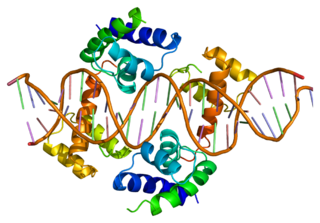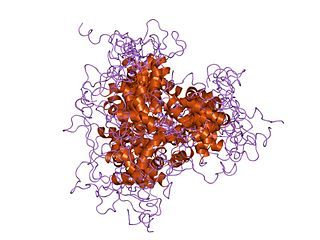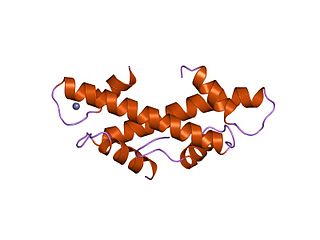Related Research Articles

In molecular biology, a transcription factor (TF) is a protein that controls the rate of transcription of genetic information from DNA to messenger RNA, by binding to a specific DNA sequence. The function of TFs is to regulate—turn on and off—genes in order to make sure that they are expressed in the desired cells at the right time and in the right amount throughout the life of the cell and the organism. Groups of TFs function in a coordinated fashion to direct cell division, cell growth, and cell death throughout life; cell migration and organization during embryonic development; and intermittently in response to signals from outside the cell, such as a hormone. There are 1500-1600 TFs in the human genome. Transcription factors are members of the proteome as well as regulome.

A homeobox is a DNA sequence, around 180 base pairs long, that regulates large-scale anatomical features in the early stages of embryonic development. Mutations in a homeobox may change large-scale anatomical features of the full-grown organism.

Oct-4, also known as POU5F1, is a protein that in humans is encoded by the POU5F1 gene. Oct-4 is a homeodomain transcription factor of the POU family. It is critically involved in the self-renewal of undifferentiated embryonic stem cells. As such, it is frequently used as a marker for undifferentiated cells. Oct-4 expression must be closely regulated; too much or too little will cause differentiation of the cells.
A DNA-binding domain (DBD) is an independently folded protein domain that contains at least one structural motif that recognizes double- or single-stranded DNA. A DBD can recognize a specific DNA sequence or have a general affinity to DNA. Some DNA-binding domains may also include nucleic acids in their folded structure.

POU domain, class 1, transcription factor 1 , also known as POU1F1, is a transcription factor for growth hormone.
Octamer transcription factors are a family of transcription factors which binds to the "ATTTGCAT" DNA sequence. Their DNA-binding domain is a POU domain.
Oct-2 also known as POU domain, class 2, transcription factor 2 is a protein that in humans is encoded by the POU2F2 gene.

High-mobility group protein HMG-I/HMG-Y is a protein that in humans is encoded by the HMGA1 gene.

POU domain, class 2, transcription factor 1 is a protein that in humans is encoded by the POU2F1 gene.

High-mobility group protein B2 also known as high-mobility group protein 2 (HMG-2) is a protein that in humans is encoded by the HMGB2 gene.

POU domain class 2-associating factor 1 is a protein that in humans is encoded by the POU2AF1 gene. The protein is also termed Oct coactivator from B cells, Oct binding factor 1, and, as commonly found in the literature, BOB1. BOB1 is a transcriptional coactivator which is expressed principally by B-cell lymphocytes and controls immunoglobulin and other genes critical for these cells expression of CD20, CRISP-3, and CD36. The expression of BOB1 has proven useful for identifying certain lymphomas as being B-cell lymphomas, as exemplified in studies which use BAB1 expression to help identify lymphomas as being diffuse large B-cell lymphomas, not otherwise specified.

Solute carrier family 22 member 1 is a protein that in humans is encoded by the gene SLC22A1.

POU domain, class 3, transcription factor 2 is a protein that in humans is encoded by the POU3F2 gene.

POU domain, class 4, transcription factor 1 (POU4F1) also known as brain-specific homeobox/POU domain protein 3A (BRN3A), homeobox/POU domain protein RDC-1 or Oct-T1 is a protein that in humans is encoded by the POU4F1 gene.

POU domain, class 3, transcription factor 1 is a protein that in humans is encoded by the POU3F1 gene.

POU domain, class 2, transcription factor 3 is a protein that in humans is encoded by the POU2F3 gene.

The Rel homology domain (RHD) is a protein domain found in a family of eukaryotic transcription factors, including both NF-κB and NFAT, among others. Some of these transcription factors appear to form multi-protein DNA-bound complexes. Phosphorylation of the RHD appears to play a role in the regulation of some of these transcription factors, acting to modulate the expression of their target genes.

The fork head domain is a type of protein domain that is often found in transcription factors and whose purpose is to bind DNA.

The TBP-associated factors (TAF) are proteins that associate with the TATA-binding protein in transcription initiation. It is a part of the transcription initiation factor TFIID multimeric protein complex. It also makes up many other factors, including SL1. They mediate the formation of the transcription preinitiation complex, a step preceding transcription of DNA to RNA by RNA polymerase II.

PBX/Knotted 1 Homeobox 2 (PKNOX2) protein belongs to the three amino acid loop extension (TALE) class of homeodomain proteins, and is encoded by PKNOX2 gene in humans. The protein regulates the transcription of other genes and affects anatomical development.
References
- ↑ Phillips K, Luisi B (Oct 2000). "The virtuoso of versatility: POU proteins that flex to fit". Journal of Molecular Biology. 302 (5): 1023–39. doi:10.1006/jmbi.2000.4107. PMID 11183772.
- ↑ Gold, David A.; Gates, Ruth D.; Jacobs, David K. (2014-12-01). "The Early Expansion and Evolutionary Dynamics of POU Class Genes". Molecular Biology and Evolution. 31 (12): 3136–3147. doi:10.1093/molbev/msu243. ISSN 0737-4038. PMC 4245813 . PMID 25261405.
- ↑ D'Souza C, Nakano MM, Zuber P (September 1994). "Identification of comS, a gene of the srfA operon that regulates the establishment of genetic competence in Bacillus subtilis". Proc. Natl. Acad. Sci. U.S.A. 91 (20): 9397–401. doi: 10.1073/pnas.91.20.9397 . PMC 44819 . PMID 7937777.
- ↑ Assa-Munt N, Mortishire-Smith RJ, Aurora R, Herr W, Wright PE (Apr 1993). "The solution structure of the Oct-1 POU-specific domain reveals a striking similarity to the bacteriophage lambda repressor DNA-binding domain". Cell. 73 (1): 193–205. doi:10.1016/0092-8674(93)90171-L. PMID 8462099. S2CID 24276357.
- ↑ Andersen B, Rosenfeld MG (Feb 2001). "POU domain factors in the neuroendocrine system: lessons from developmental biology provide insights into human disease". Endocrine Reviews. 22 (1): 2–35. doi: 10.1210/edrv.22.1.0421 . PMID 11159814.
- ↑ Petryniak B, Staudt LM, Postema CE, McCormack WT, Thompson CB (Feb 1990). "Characterization of chicken octamer-binding proteins demonstrates that POU domain-containing homeobox transcription factors have been highly conserved during vertebrate evolution". Proceedings of the National Academy of Sciences of the United States of America. 87 (3): 1099–1103. doi: 10.1073/pnas.87.3.1099 . PMC 53418 . PMID 1967834.
- ↑ Johnson WA, Hirsh J (Feb 1990). "Binding of a Drosophila POU-domain protein to a sequence element regulating gene expression in specific dopaminergic neurons". Nature. 343 (6257): 467–470. doi:10.1038/343467a0. PMID 1967821. S2CID 9315961.
- ↑ Mathis JM, Simmons DM, He X, Swanson LW, Rosenfeld MG (Jul 1992). "Brain 4: a novel mammalian POU domain transcription factor exhibiting restricted brain-specific expression". The EMBO Journal. 11 (7): 2551–2561. doi:10.1002/j.1460-2075.1992.tb05320.x. PMC 556730 . PMID 1628619.
- 1 2 Phillips K, Luisi B (Oct 2000). "The virtuoso of versatility: POU proteins that flex to fit". Journal of Molecular Biology. 302 (5): 1023–1039. doi:10.1006/jmbi.2000.4107. PMID 11183772.
- 1 2 Klemm JD, Rould MA, Aurora R, Herr W, Pabo CO (Apr 1994). "Crystal structure of the Oct-1 POU domain bound to an octamer site: DNA recognition with tethered DNA-binding modules". Cell. 77 (1): 21–32. doi:10.1016/0092-8674(94)90231-3. PMID 8156594. S2CID 36371069.
- ↑ Jacobson EM, Li P, Leon-del-Rio A, Rosenfeld MG, Aggarwal AK (Jan 1997). "Structure of Pit-1 POU domain bound to DNA as a dimer: unexpected arrangement and flexibility". Genes & Development. 11 (2): 198–212. doi: 10.1101/gad.11.2.198 . PMID 9009203.